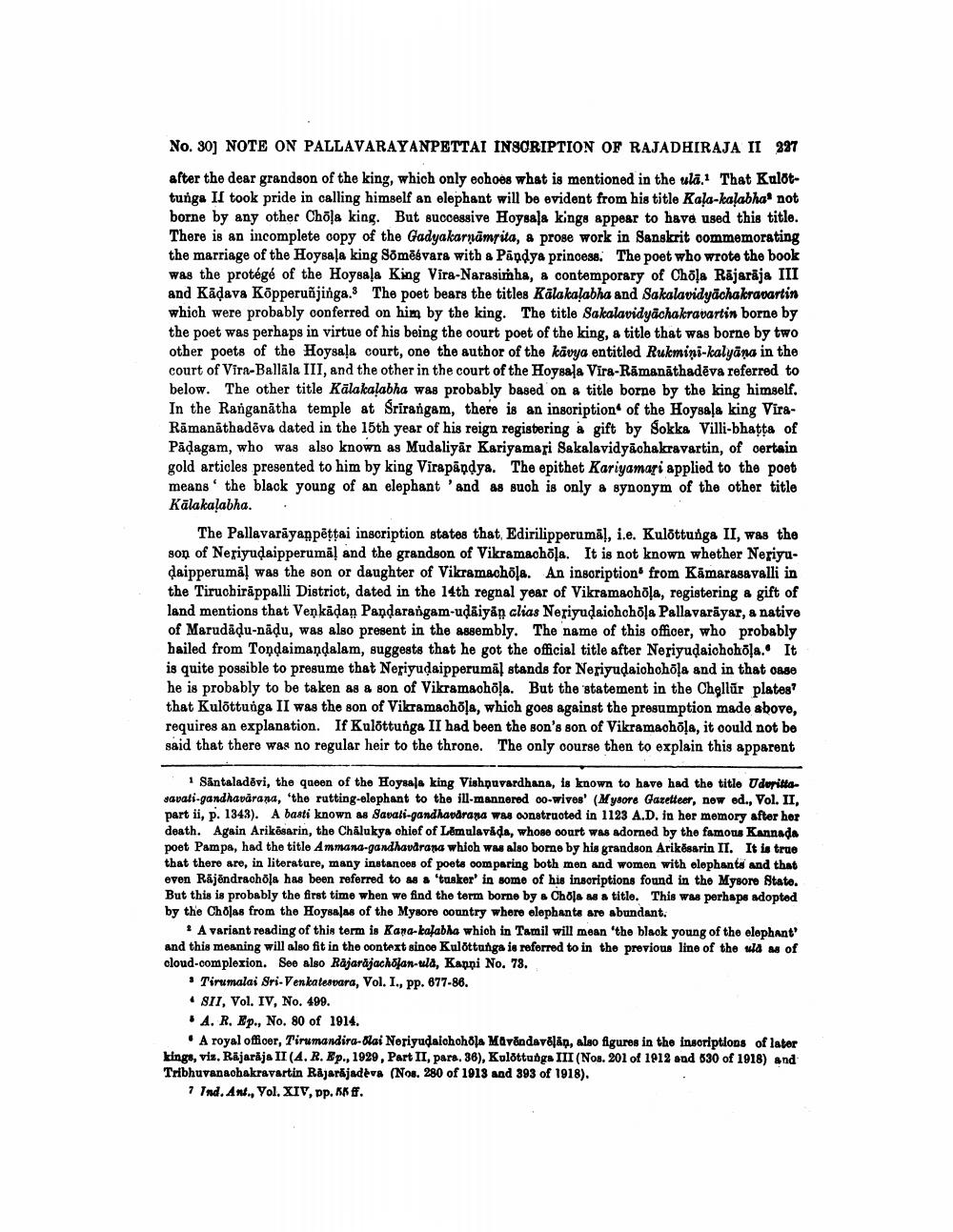________________
No. 30) NOTE ON PALLAVARAYANPETTAI INSCRIPTION OF RAJADHIRAJA II 227
after the dear grandson of the king, which only echoes what is mentioned in the ula. That Kulottunga II took pride in calling himself an elephant will be evident from his title Kaļa-kalabha not borne by any other Choļa king. But successive Hoysala kings appear to have used this title. There is an incomplete copy of the Gadyakarnāmpita, a prose work in Sanskrit commemorating the marriage of the Hoysaļa king Somēśvara with a Pandya princess. The poet who wrote the book was the protégé of the Hoysaļa King Vira-Narasimha, a contemporary of Chöļa Rājarāja III and Kādava Kõpperuõjinga. The poet bears the titles Kalakalabha and Sakalavidyāchakravartin which were probably conferred on him by the king. The title Sakalavidyāchakravartin borne by the poet was perhaps in virtue of his being the court poet of the king, a title that was borne by two other poets of the Hoysa!a court, one the author of the kavya entitled Rukmini-kalyāna in the court of Vira-Ballāla III, and the other in the court of the Hoysala Vira-Rāmanāthadēva referred to below. The other title Kālakalabha was probably based on a title borne by the king himself. In the Ranganātha temple at Srirangam, there is an insoription of the Hoysala king ViraRāmanāthadēva dated in the 15th year of his reign registering å gift by Sokka Villi-bhatta of Pādagam, who was also known as Mudaliyar Kariyamari Sakalavidyāchakravartin, of oertain gold articles presented to him by king Virapāņdya. The epithet Kariyamari applied to the poet means the black young of an elephant 'and as such is only a synonym of the other title Kālakaļabha.
The Pallavarāyanpēttai inscription states that, Edirilipperumāļ, i.e. Kulottunga II, was the son of Neriyudaipperumāļ and the grandson of Vikramachöļa. It is not known whether Neriyudaipperumā! was the son or daughter of Vikramachõļa. An insoription from Kamarasavalli in the Tiruchirappalli District, dated in the 14th regnal year of Vikramachola, registering & gift of land mentions that Venkadan Pandarangam-udāiyån clias Neriyudaiohohola Pallavarāyar, a native of Marudâdu-nädu, was also present in the assembly. The name of this officer, who probably hailed from Tondaimandalam, suggests that he got the official title after Neriyudaichohola. It is quite possible to presume that Neriyudaipperumāļ stands for Neriyudaichohola and in that 088e he is probably to be taken as a son of Vikramachöļa. But the statement in the Chellür plates? that Kulottuðga II was the son of Vikramachola, which goes against the presumption made above, requires an explanation. If Kulottunga II had been the son's son of Vikramachoļa, it oould not be said that there was no regular heir to the throne. The only course then to explain this apparent
1 Såntaladevi, the queen of the Hoysals king Vishnuvardhana, is known to have had the title Udupitia savati-gandhavárana, 'the rutting-elephant to the ill-mannered 00-wives' (Mysore Gazetteer, now ed., Vol. II, part ii, p. 1343). A basti known as Savati-gandhandrana was constructed in 1123 A.D. in her memory after her death. Again Arikasarin, the Chalukya chief of Lēmulavads, whose court was adorned by the famous Kannada poet Pampa, had the title Ammana-gandhavdrans which was also bomo by his grandson Arikësarin II. It is true that there are, in literature, many instances of poets comparing both men and women with elephants and that even Rajendrachola has been referred to as 'tasker' in some of his inscriptions found in the Mysoro Stato. But this is probably the first time when we find the term borne by & Chols ma title. This was perhaps adopted by the Cholas from the Hoysalas of the Mysore country where elephants are abundant.
* A variant reading of this term is Kana-kalabha which in Tamil will mean the black young of the elephant' and this meaning will also fit in the context since Kulottanga is referred to in the previous line of the wld as of cloud-complexion. See also Rajarajachofan-ula, Kanni No. 78.
• Tirumalai Sri Venkateswara, Vol. I., pp. 677-86. • SII, Vol. IV, No. 499. . A. R. Ep., No. 80 of 1914.
• A royal officer, Tirumandira-Mai Noriyudaichohola Mavendavolan, also figures in the insoriptions of later kings, viz, Rajaraja II (4. R. Ep., 1929, Part II, pars. 36), Kulottunga III (Nos. 201 of 1012 and 130 of 1918) and Tribhuvanachakravartin Rajarajadeva (Nos. 280 of 1913 and 393 of 1918).
7 Ind. Ant., Vol. XIV, pp. KK ff.




